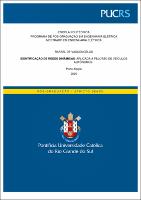| Share record |


|
Please use this identifier to cite or link to this item:
https://tede2.pucrs.br/tede2/handle/tede/9999| Document type: | Dissertação |
| Title: | Identificação de redes dinâmicas : aplicada a pelotão de veículos autônomos |
| Author: | Vasconcelos, Rafael de  |
| Advisor: | Pimentel, Guilherme Araujo |
| Abstract (native): | Redes dinâmicas estão presentes em problemas de engenharia, biologia, economia, e modelam as interconexões dinâmicas que ocorrem dentro dos sistemas. A identificação do modelo da rede é uma ferramenta para aprimorar o controle e manuseio de sistemas complexos. Neste trabalho, será aplicado o conceito de identificação de redes dinâmicas em um pelotão de veículos autônomos. O objetivo da formação de um pelotão com os veículos é de minimizar o arrasto aerodinâmico e, assim, gerar economia de combustível e diminuição da emissão de poluentes. Para alcançar resultados significativos de economia, é necessário manter pequenos espaços entre os veículos e, para manter o menor espaçamento com segurança, o uso de veículos autônomos é aplicado. Nesta dissertação, duas topologias de rede serão apresentadas para descrever o pelotão de veículos, e o resultado da identificação por modelagem numérica das funções de transferência será apresentado para cada uma das topologias. A modelagem dos veículos é feita de forma que o coeficiente de arrasto aerodinâmico dos veículos também seja identificada. A topologia de rede influencia na variância dos parâmetros identificados, sendo a rede com maior profundidade a com melhor resultado. |
| Abstract (english): | Dynamic networks are present in systems from different areas, such as engineering, biology, economics, and model the dynamic connections that occur within the systems. The network model identification is a tool to improve the control and handling of complex systems. In this work, the concept of network identification will be applied in a platoon of autonomous vehicles. The objective of forming a platoon with vehicles is to minimize aerodynamic drag and thus generate fuel savings and decrease pollutant emissions. To achieve significant savings results it is necessary to maintain small spaces between vehicles, and to maintain the smallest spacing safely the use of autonomous vehicles is applied. In this work, two network topologies are presented to describe the vehicle platoon, and the result of the identification by numerical modeling of the transfer functions is presented for each of the topologies. The modeling of vehicles is done in such a way that the aerodynamic drag coefficient of the vehicles is also identified. We conclude that the network topology influences the variance of the identified signals, and the network with greater depth presents better results. |
| Keywords: | Formação de Pelotões Veículos Autônomos Identificação de Parâmetros Redes Dinâmicas Variáveis Instrumentais Coeficiente de Arrasto Aerodinâmico Platoon Formation Autonomous Vehicles Parameter Identification Dynamic Networks Instrumental Variables Aerodynamic Height Coefficient |
| CNPQ Knowledge Areas: | ENGENHARIAS |
| Language: | por |
| Country: | Brasil |
| Publisher: | Pontifícia Universidade Católica do Rio Grande do Sul |
| Institution Acronym: | PUCRS |
| Department: | Escola Politécnica |
| Program: | Programa de Pós-Graduação em Engenharia Elétrica |
| Access type: | Acesso Aberto |
| Fulltext access restriction: | Trabalho não apresenta restrição para publicação |
| URI: | http://tede2.pucrs.br/tede2/handle/tede/9999 |
| Issue Date: | 8-Sep-2020 |
| Appears in Collections: | Programa de Pós-Graduação em Engenharia Elétrica |
Files in This Item:
| File | Description | Size | Format | |
|---|---|---|---|---|
| RAFAEL DE VASCONCELOS_DIS.pdf | RAFAEL_DE_VASCONCELOS_DIS | 3.23 MB | Adobe PDF |  Download/Open Preview |
Items in DSpace are protected by copyright, with all rights reserved, unless otherwise indicated.




